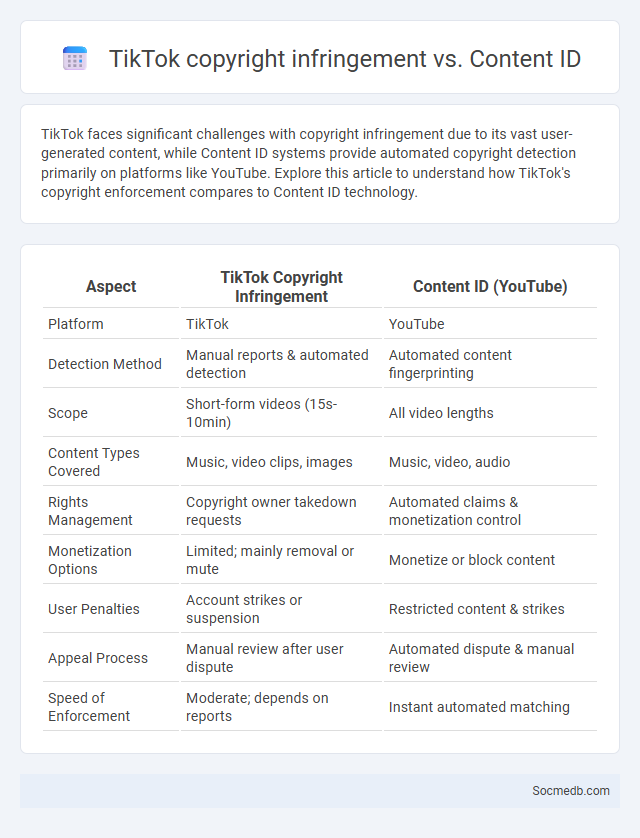
Photo illustration: TikTok copyright infringement vs content ID
TikTok faces significant challenges with copyright infringement due to its vast user-generated content, while Content ID systems provide automated copyright detection primarily on platforms like YouTube. Explore this article to understand how TikTok's copyright enforcement compares to Content ID technology.
Table of Comparison
| Aspect | TikTok Copyright Infringement | Content ID (YouTube) |
|---|---|---|
| Platform | TikTok | YouTube |
| Detection Method | Manual reports & automated detection | Automated content fingerprinting |
| Scope | Short-form videos (15s-10min) | All video lengths |
| Content Types Covered | Music, video clips, images | Music, video, audio |
| Rights Management | Copyright owner takedown requests | Automated claims & monetization control |
| Monetization Options | Limited; mainly removal or mute | Monetize or block content |
| User Penalties | Account strikes or suspension | Restricted content & strikes |
| Appeal Process | Manual review after user dispute | Automated dispute & manual review |
| Speed of Enforcement | Moderate; depends on reports | Instant automated matching |
Understanding TikTok Copyright Infringement
TikTok copyright infringement occurs when users upload or share content that violates the intellectual property rights of others, including music, videos, or images without proper authorization. Understanding TikTok's copyright policies helps you avoid penalties such as content removal or account suspension while respecting creators' rights. Familiarize yourself with TikTok's licensing agreements and tools like the Rights Manager to monitor and protect your own content effectively.
What Is Content ID?
Content ID is a powerful digital fingerprinting system developed by YouTube to automatically identify and manage copyrighted material in videos. It scans uploads for matches against a database of copyrighted audio and video, enabling rights holders to monetize, track, or block unauthorized use. By using Content ID, You can protect your original content and ensure proper attribution or monetization across the platform.
TikTok’s Copyright Policies Explained
TikTok's copyright policies are designed to protect both creators and rights holders by enforcing strict guidelines against unauthorized use of protected content. You must ensure your videos do not infringe on others' copyrighted music, videos, or images, as repeated violations can lead to account suspension. TikTok employs automated detection tools and allows copyright owners to submit takedown requests, maintaining a balance between creative expression and intellectual property rights.
Key Differences: TikTok Infringement vs Content ID
TikTok infringement involves unauthorized use or copying of copyrighted content without permission, often leading to direct violations of intellectual property rights. Content ID, developed by YouTube, uses automated digital fingerprinting technology to identify copyrighted material and manage rights by allowing copyright holders to monetize, track, or block unauthorized uses. The key difference lies in TikTok's manual or reactive infringement handling versus Content ID's proactive, automated detection and management system.
Legal Framework: Copyright Law and Social Media
Social media platforms are governed by complex copyright laws designed to protect original content while regulating user interactions and sharing. Your posts, images, and videos are subject to copyright protections, requiring adherence to fair use guidelines and proper attribution to avoid infringement. Understanding the legal framework helps safeguard your intellectual property and ensures compliance with platform policies and national regulations.
How TikTok Handles Copyright Claims
TikTok employs an automated content recognition system that identifies copyrighted material based on digital fingerprinting and user reports. When a copyright claim is filed, TikTok promptly reviews the content and may mute audio, remove the video, or restrict its visibility to comply with copyright laws. The platform also provides creators with a clear process to dispute claims and appeal decisions, ensuring balanced copyright enforcement and content protection.
Content ID on YouTube vs TikTok Enforcement
YouTube's Content ID system uses a vast database of copyrighted material to automatically identify and manage content, enabling rights holders to monetize, block, or track videos with their material. TikTok relies on a more manual enforcement process combined with automated filters, often requiring rights holders to submit claims directly rather than using a comprehensive automated matching system. YouTube's advanced Content ID technology provides more efficient and scalable protection for copyrighted content compared to TikTok's enforcement approach.
Common Types of Copyright Infringement on TikTok
Common types of copyright infringement on TikTok include unauthorized use of copyrighted music, video clips, and images. Users often repost or remix content without obtaining proper licenses or permissions, violating intellectual property rights. TikTok's content identification system sometimes detects these infringements, leading to content removal or account penalties.
Creative Rights: Protecting Your Content on TikTok
Protecting your creative rights on TikTok involves understanding copyright laws and utilizing the platform's tools to safeguard your original content. TikTok offers features like digital watermarks and copyright infringement reporting to help you maintain ownership and control over your videos. Ensuring your content is properly credited and actively monitoring for unauthorized use strengthens your ability to defend your creative work.
Future Trends in Copyright and Social Media Platforms
Social media platforms are increasingly integrating advanced AI-driven tools to detect and manage copyright infringement, enhancing content protection for creators and users alike. Blockchain technology is emerging as a key solution for transparent and immutable copyright tracking, ensuring fair attribution and monetization of digital assets. You can expect more robust legal frameworks and platform policies to evolve, balancing user-generated content freedom with stringent intellectual property enforcement.
 socmedb.com
socmedb.com